Oscillatory Motion and Waves and Physics of Hearing.
132 Sound Interference and Resonance: Standing Waves in Air Columns
Learning Objectives
- Define antinode, node, fundamental, overtones, and harmonics.
- Identify examples of sound interference in everyday situations.
- Describe how interference in open and closed tubes affects sound characteristics and musical instrument design.
- Calculate the length of a resonating tube using sound wave measurements.
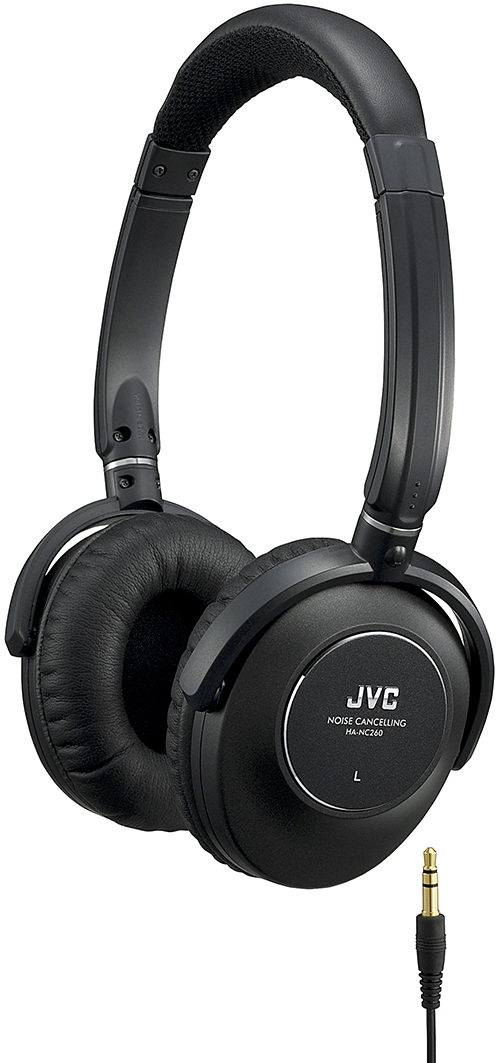
All waves, including sound waves, exhibit interference. This property—constructive and destructive interference—is a defining feature of wave behavior. Interference patterns offer strong evidence that a phenomenon is indeed wave-like. For sound, we’ve already seen interference effects in phenomena such as beats generated by two similar frequencies.
Figure 132.2 demonstrates an application of destructive interference in active noise-canceling headphones. These systems use electronics to generate a second sound wave that is the mirror image of the unwanted noise. The pressure variations of the original and the canceling sound waves combine to reduce the overall pressure variation, thereby lowering the sound intensity. This technique can reduce noise levels by over 30 dB.
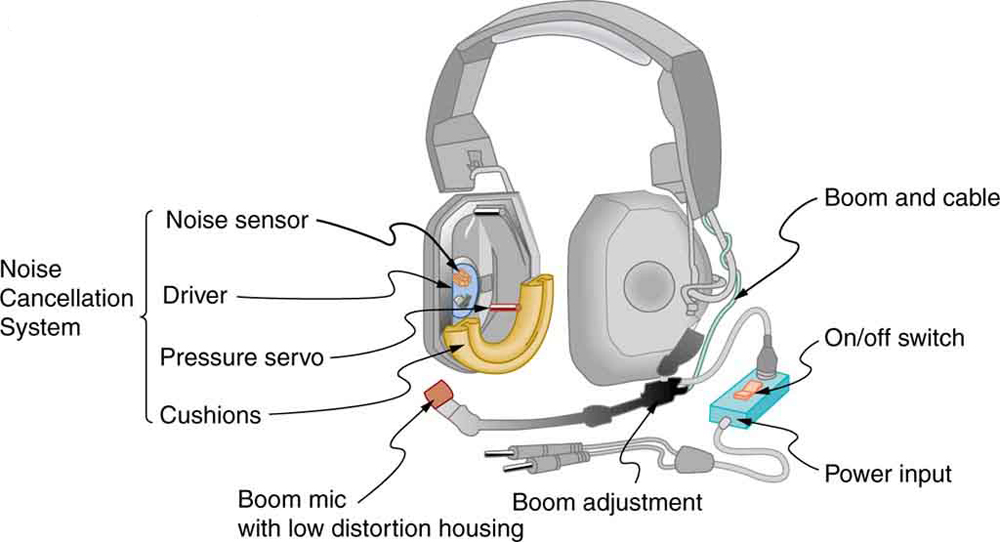
We also observe interference in musical instruments. All resonances in instruments are the result of interference. Constructive interference forms standing waves at resonant frequencies, while destructive interference suppresses all others. From blowing across a bottle to the acoustics of a violin body, interference is central to sound production and timbre.
Interference
Interference is so fundamental to wave behavior that observing it confirms a phenomenon is wave-like. Light and even electrons have demonstrated interference, reinforcing their wave-particle duality.
Now, consider placing a vibrating tuning fork near one end of a tube closed at the other end, as shown in Figure 132.3, Figure 132.4, Figure 132.5, and Figure 132.6. If the tube’s length corresponds to a resonant frequency, the air column will vibrate strongly. The incoming sound wave reflects at the closed end and interferes with the ongoing wave. If this interference is constructive, a standing wave forms.
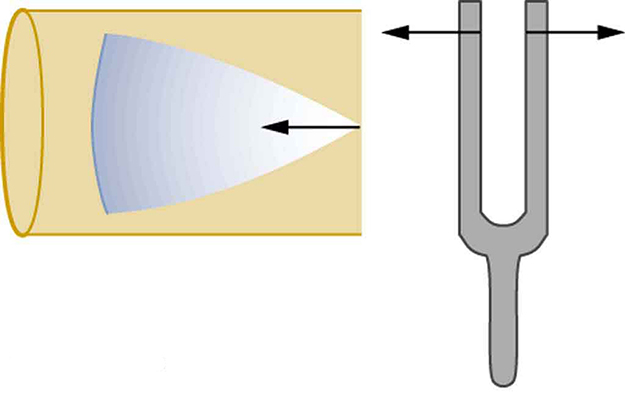
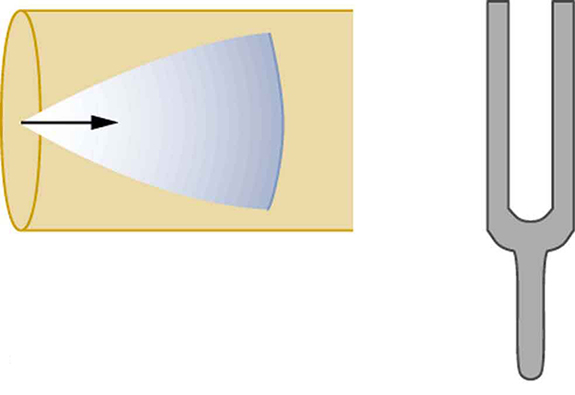
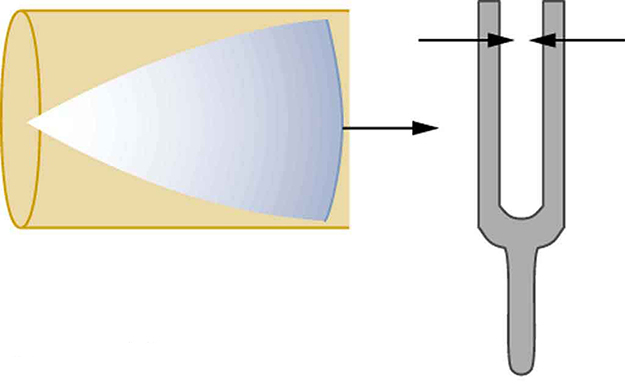

In a closed-end tube, the displacement is zero at the closed end (node) and maximum at the open end (antinode). This configuration supports a wave where the tube length equals one-quarter of the wavelength.
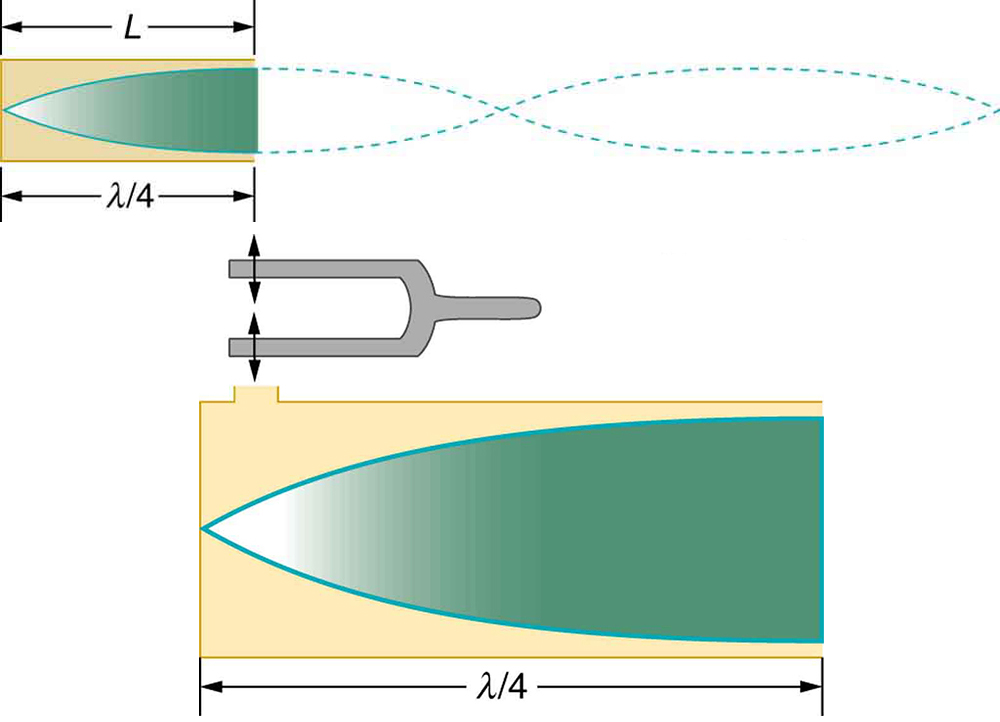
Shorter wavelengths can also resonate. Figure 132.8 shows a standing wave with three-fourths of a wavelength inside the tube:

Each resonant frequency is an odd multiple of the fundamental. These frequencies are:
where [latex]v_w[/latex] is the speed of sound. The fundamental is the first harmonic ([latex]n=1[/latex]), and the overtones are higher harmonics. Figure 132.9 shows the first four resonant frequencies in such a system.

Musical instruments like trumpets and clarinets use these resonant properties to create rich sounds. Though middle C is the same pitch on both instruments, their tone differs due to different overtone combinations and intensities. The same applies to the human voice, where mouth and throat shape modulate the overtone spectrum to produce distinct vowel sounds, as shown in Figure 132.10.
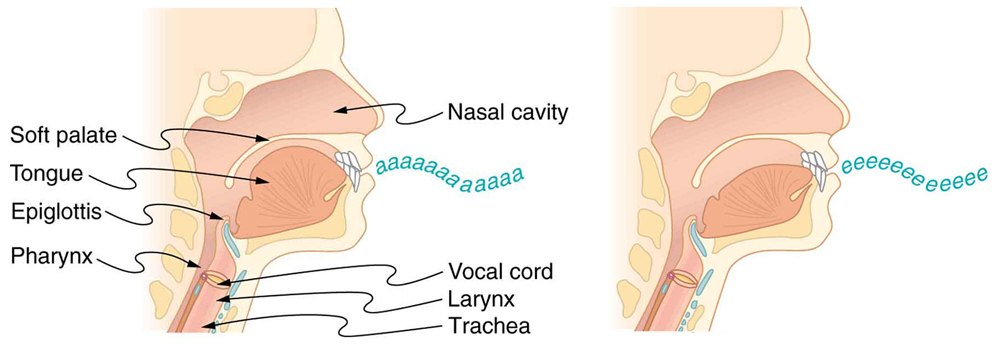
Finally, we can express the fundamental frequency mathematically as:
The first overtone is:
Thus, the general pattern of resonant frequencies in a closed-end tube is:
These resonances depend on temperature, as sound speed increases with temperature. That’s why musicians warm up their wind instruments and why temperature can affect tuning in cold environments like old cathedrals.
Example 132.1: Find the Length of a Tube with a 128 Hz Fundamental
- What length should a tube closed at one end have on a day when the air temperature, is [latex]22.0ºC[/latex], if its fundamental frequency is to be 128 Hz (C below middle C)?
- What is the frequency of its fourth overtone?
Strategy
The length [latex]L[/latex] can be found from the relationship in [latex]{f}_{n}=n\frac{{v}_{w}}{4L}[/latex], but we will first need to find the speed of sound [latex]{v}_{w}[/latex].
Solution for (a)
- Identify knowns:
- • the fundamental frequency is 128 Hz
- • the air temperature is [latex]22.0ºC[/latex]
- Use [latex]{f}_{n}=n\frac{{v}_{w}}{4L}[/latex] to find the fundamental frequency ([latex]n=1[/latex]).
[latex]{f}_{1}=\frac{{v}_{w}}{4L}[/latex]
- Solve this equation for length.
[latex]L=\frac{{v}_{w}}{{4f}_{1}}[/latex]
- Find the speed of sound using [latex]{v}_{w}=\left(\text{331 m/s}\right)\sqrt{\frac{T}{\text{273 K}}}[/latex] .
[latex]{v}_{w}=\left(\text{331 m/s}\right)\sqrt{\frac{\text{295 K}}{\text{273 K}}}=\text{344 m/s}[/latex]
- Enter the values of the speed of sound and frequency into the expression for [latex]L[/latex].
[latex]L=\frac{{v}_{w}}{{4f}_{1}}=\frac{\text{344 m/s}}{4\left(\text{128 Hz}\right)}=0\text{.}\text{672 m}[/latex]
Discussion on (a)
Many wind instruments are modified tubes that have finger holes, valves, and other devices for changing the length of the resonating air column and hence, the frequency of the note played. Horns producing very low frequencies, such as tubas, require tubes so long that they are coiled into loops.
Solution for (b)
- Identify knowns:
- • the first overtone has [latex]n=3[/latex]
- • the second overtone has [latex]n=5[/latex]
- • the third overtone has [latex]n=7[/latex]
- • the fourth overtone has [latex]n=9[/latex]
- Enter the value for the fourth overtone into [latex]{f}_{n}=n\frac{{v}_{w}}{4L}[/latex].
[latex]{f}_{9}=9\frac{{v}_{w}}{4L}={9f}_{1}=\text{1.15 kHz}[/latex]
Discussion on (b)
Whether this overtone occurs in a simple tube or a musical instrument depends on how it is stimulated to vibrate and the details of its shape. The trombone, for example, does not produce its fundamental frequency and only makes overtones.
Tubes Open at Both Ends
Another type of tube is one that is open at both ends. Examples include organ pipes, flutes, and oboes. The resonances of tubes open at both ends can be analyzed similarly to those of tubes closed at one end. In these tubes, the air columns have maximum displacement (antinode) at both ends, as illustrated in Figure 132.11. Standing waves form as shown for the fundamental and its overtones.

Since maximum air displacements occur at both ends, the standing wave patterns in an open-open tube have a displacement antinode at each end. Based on this boundary condition and guided by Figure 132.11, the resonant frequencies of a tube open at both ends are given by:
Here, [latex]f_1[/latex] is the fundamental frequency, [latex]f_2[/latex] is the first overtone, and so on. Compared to a closed-end tube of the same length, an open-open tube has a fundamental frequency that is twice as high. It also includes both even and odd multiples of the fundamental in its overtone series, unlike closed tubes, which only contain odd harmonics. Therefore, if you played two tubes with the same fundamental frequency—one open at both ends and one closed at one end—they would sound different. The open tube would sound richer due to its wider overtone spectrum.
Real-World Applications: Resonance in Everyday Systems
Resonance is a common phenomenon in many systems including strings, air columns, and even atomic structures. It is the driven or forced oscillation of a system at its natural frequency. At resonance, energy transfers efficiently, and the amplitude grows until nonlinear effects limit it. An example is the intentionally distorted sound produced in some types of rock music by overdriving the natural resonance of a system.
Sound Amplification Through Resonance
Wind instruments use air column resonance to amplify tones produced by lips or vibrating reeds. Other instruments, like violins and guitars, use sounding boxes to resonate and amplify string vibrations. Figure 132.12 shows how the body of these instruments plays a critical role in shaping their sound. The bridge transmits string vibrations to the body, which resonates and adds overtones to the sound. More complex sounding box shapes allow for resonance across a broader frequency range. The marimba, shown in Figure 132.13, uses gourds as resonance chambers, and their tuning can be adjusted by adding water.
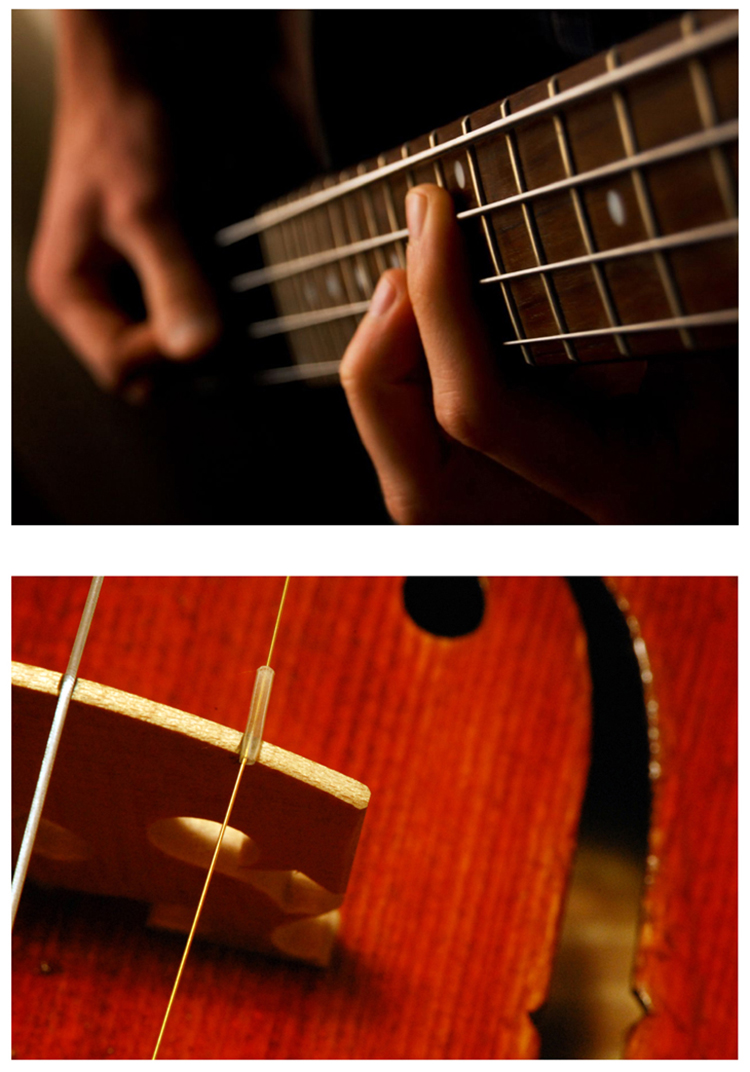

Although we’ve focused on sound, resonance and standing wave concepts apply to any wave system. For instance, vibrating strings also support fundamental and overtone frequencies. Even atomic orbitals can be interpreted as standing waves of electrons with quantized energy levels. These similarities across physical systems show the universal nature of wave behavior and resonance.
Check Your Understanding
1. Describe how noise-canceling headphones differ from standard headphones used to block outside sounds.
Solution: Regular headphones block external sound with a physical barrier. Noise-canceling headphones use destructive interference to cancel out sound waves by producing an inverted version of the incoming noise.
2. How is it possible to use a standing wave’s node and antinode to determine the length of a closed-end tube?
Solution: In resonance, the node is at the closed end and the antinode is at the open end. This corresponds to one-quarter of a wavelength. So if you know the wave’s wavelength, the tube’s length can be calculated using [latex]L = \frac{\lambda}{4}[/latex].
PhET Explorations: Sound
This simulation lets you visualize sound waves. You can adjust the frequency and amplitude, observe changes in the waveform, and even move the listener to hear different effects.
Section Summary
- Sound interference and resonance follow general wave properties.
- The lowest-frequency resonance in an air column is the fundamental; higher resonances are overtones, and together they form the harmonic series.
- The resonant frequencies of a tube closed at one end are:
[latex]f_n = n\frac{v_w}{4L}, \quad n = 1, 3, 5, \dots[/latex]
- The resonant frequencies of a tube open at both ends are:
[latex]f_n = n\frac{v_w}{2L}, \quad n = 1, 2, 3, \dots[/latex]
Conceptual Questions
- How does an unamplified guitar produce sounds so much more intense than those of a plucked string held taut by a simple stick?
- You are given two wind instruments of identical length. One is open at both ends, whereas the other is closed at one end. Which is able to produce the lowest frequency?
- What is the difference between an overtone and a harmonic? Are all harmonics overtones? Are all overtones harmonics?
Problems & Exercises
- A “showy” custom-built car has two brass horns that are supposed to produce the same frequency but actually emit 263.8 and 264.5 Hz. What beat frequency is produced?
- What beat frequencies will be present: (a) If the musical notes A and C are played together (frequencies of 220 and 264 Hz)? (b) If D and F are played together (frequencies of 297 and 352 Hz)? (c) If all four are played together?
- What beat frequencies result if a piano hammer hits three strings that emit frequencies of 127.8, 128.1, and 128.3 Hz?
- A piano tuner hears a beat every 2.00 s when listening to a 264.0-Hz tuning fork and a single piano string. What are the two possible frequencies of the string?
- (a) What is the fundamental frequency of a 0.672-m-long tube, open at both ends, on a day when the speed of sound is 344 m/s? (b) What is the frequency of its second harmonic?
- If a wind instrument, such as a tuba, has a fundamental frequency of 32.0 Hz, what are its first three overtones? It is closed at one end. (The overtones of a real tuba are more complex than this example, because it is a tapered tube.)
- What are the first three overtones of a bassoon that has a fundamental frequency of 90.0 Hz? It is open at both ends. (The overtones of a real bassoon are more complex than this example, because its double reed makes it act more like a tube closed at one end.)
- How long must a flute be in order to have a fundamental frequency of 262 Hz (this frequency corresponds to middle C on the evenly tempered chromatic scale) on a day when air temperature is [latex]20.0ºC[/latex]? It is open at both ends.
- What length should an oboe have to produce a fundamental frequency of 110 Hz on a day when the speed of sound is 343 m/s? It is open at both ends.
- What is the length of a tube that has a fundamental frequency of 176 Hz and a first overtone of 352 Hz if the speed of sound is 343 m/s?
- (a) Find the length of an organ pipe closed at one end that produces a fundamental frequency of 256 Hz when air temperature is [latex]18.0ºC[/latex]. (b) What is its fundamental frequency at [latex]25.0ºC[/latex]?
- By what fraction will the frequencies produced by a wind instrument change when air temperature goes from [latex]10.0ºC[/latex] to [latex]30.0ºC[/latex]? That is, find the ratio of the frequencies at those temperatures.
- The ear canal resonates like a tube closed at one end. (See Chapter 17.6 The Hearing Mechanism.) If ear canals range in length from 1.80 to 2.60 cm in an average population, what is the range of fundamental resonant frequencies? Take air temperature to be [latex]37.0ºC[/latex], which is the same as body temperature. How does this result correlate with the intensity versus frequency graph (Figure 132.3 of the human ear?
- Calculate the first overtone in an ear canal, which resonates like a 2.40-cm-long tube closed at one end, by taking air temperature to be [latex]37.0ºC[/latex]. Is the ear particularly sensitive to such a frequency? (The resonances of the ear canal are complicated by its nonuniform shape, which we shall ignore.)
- A crude approximation of voice production is to consider the breathing passages and mouth to be a resonating tube closed at one end. (See Figure 132.10.) (a) What is the fundamental frequency if the tube is 0.240-m long, by taking air temperature to be [latex]37.0ºC[/latex]? (b) What would this frequency become if the person replaced the air with helium? Assume the same temperature dependence for helium as for air.
- (a) Students in a physics lab are asked to find the length of an air column in a tube closed at one end that has a fundamental frequency of 256 Hz. They hold the tube vertically and fill it with water to the top, then lower the water while a 256-Hz tuning fork is rung and listen for the first resonance. What is the air temperature if the resonance occurs for a length of 0.336 m? (b) At what length will they observe the second resonance (first overtone)?
- What frequencies will a 1.80-m-long tube produce in the audible range at [latex]20.0ºC[/latex] if: (a) The tube is closed at one end? (b) It is open at both ends?
Glossary
- antinode
- point of maximum displacement
- node
- point of zero displacement
- fundamental
- the lowest-frequency resonance
- overtones
- all resonant frequencies higher than the fundamental
- harmonics
- the term used to refer collectively to the fundamental and its overtones
the location of maximum amplitude in standing waves
point of zero displacement
the lowest-frequency resonance
multiples of the fundamental frequency of a sound
the term used to refer collectively to the fundamental and its overtones
the frequency of the amplitude fluctuations of a wave

